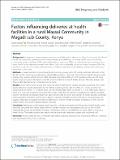| dc.contributor.author | Caulfield, Tanya | |
| dc.contributor.author | Onyo, Pamela | |
| dc.contributor.author | Byrne, Abbey | |
| dc.contributor.author | Nduba, John | |
| dc.contributor.author | Nyagero, Josephat | |
| dc.contributor.author | Morgan, Alison | |
| dc.contributor.author | Kermode, Michelle | |
| dc.date.accessioned | 2021-08-23T19:31:12Z | |
| dc.date.available | 2021-08-23T19:31:12Z | |
| dc.date.issued | 2016 | |
| dc.identifier.uri | http://repository.amref.org/handle/123456789/125 | |
| dc.description | © 2016 Caulfield et al. Open Access This article is distributed under the terms of the Creative Commons Attribution 4.0 International License (http://creativecommons.org/licenses/by/4.0/), which permits unrestricted use, distribution, and reproduction in any medium, provided you give appropriate credit to the original author(s) and the source, provide a link to the Creative Commons license, and indicate if changes were made. The Creative Commons Public Domain Dedication waiver (http://creativecommons.org/publicdomain/zero/1.0/) applies to the data made available in this article, unless otherwise stated. | en_US |
| dc.description.abstract | Background: Kenya’s high maternal mortality ratio can be partly explained by the low proportion of women delivering in health facilities attended by skilled birth attendants (SBAs). Many women continue to give birth at home attended by family members or traditional birth attendants (TBAs). This is particularly true for pastoralist women in Laikipia and Samburu counties, Kenya. This paper investigates the socio-demographic factors and cultural beliefs and practices that influence place of delivery for these pastoralist women. Methods: Qualitative data were collected in five group ranches in Laikipia County and three group ranches in Samburu County. Fifteen in-depth interviews were conducted: seven with SBAs and eight with key informants. Nineteen focus group discussions (FGDs) were conducted: four with TBAs; three with community health workers (CHWs); ten with women who had delivered in the past two years; and two with husbands of women who had delivered in the past two years. Topics discussed included reasons for homebirths, access and referrals to health facilities, and strengths and challenges of TBAs and SBAs. The data were translated, transcribed and inductively and deductively thematically analysed both manually and using NVivo. Results: Socio-demographic characteristics and cultural practices and beliefs influence pastoralist women’s place of delivery in Laikipia and Samburu counties, Kenya. Pastoralist women continue to deliver at home due to a range of factors including: distance, poor roads, and the difficulty of obtaining and paying for transport; the perception that the treatment and care offered at health facilities is disrespectful and unfriendly; lack of education and awareness regarding the risks of delivering at home; and local cultural values related to women and birthing. Conclusions: Understanding factors influencing the location of delivery helps to explain why many pastoralist women continue to deliver at home despite health services becoming more accessible. This information can be used to inform policy and program development aimed at increasing the proportion of facility-based deliveries in challenging settings. | en_US |
| dc.description.sponsorship | Australian government’s Department of Foreign Affairs and Trade. | en_US |
| dc.language.iso | en | en_US |
| dc.subject | Pastoralist | en_US |
| dc.subject | Traditional birth attendants | en_US |
| dc.subject | Homebirths | en_US |
| dc.subject | Skilled birth attendants | en_US |
| dc.subject | Kenya | en_US |
| dc.subject | Culture | en_US |
| dc.title | Factors Influencing Place of Delivery for Pastoralist Women in Kenya: A Qualitative Study | en_US |
| dc.type | Article, Journal | en_US |

